Are you struggling to keep track of your project's progress? A milestone chart might be just what you need. With its clear visual representation of goals, completed tasks, and deadlines, a milestone chart can help you stay on top of your project and ensure its success.
In this article, we'll cover the importance of milestone charts, explain their key components, and explain how to choose the right format to create your own.
Understanding the importance of milestone charts
Project management means leading a team to achieve a goal within a given time frame. Milestones and milestone charts are your path to success. So let's look at them in more detail:
What is a milestone?
Milestones are important checkpoints in project management, as they mark key progress events and provide a sense of accomplishment toward the final goal. Milestones provide clarity and structure to the project lifecycle, helping identify any areas needing extra attention or resources.
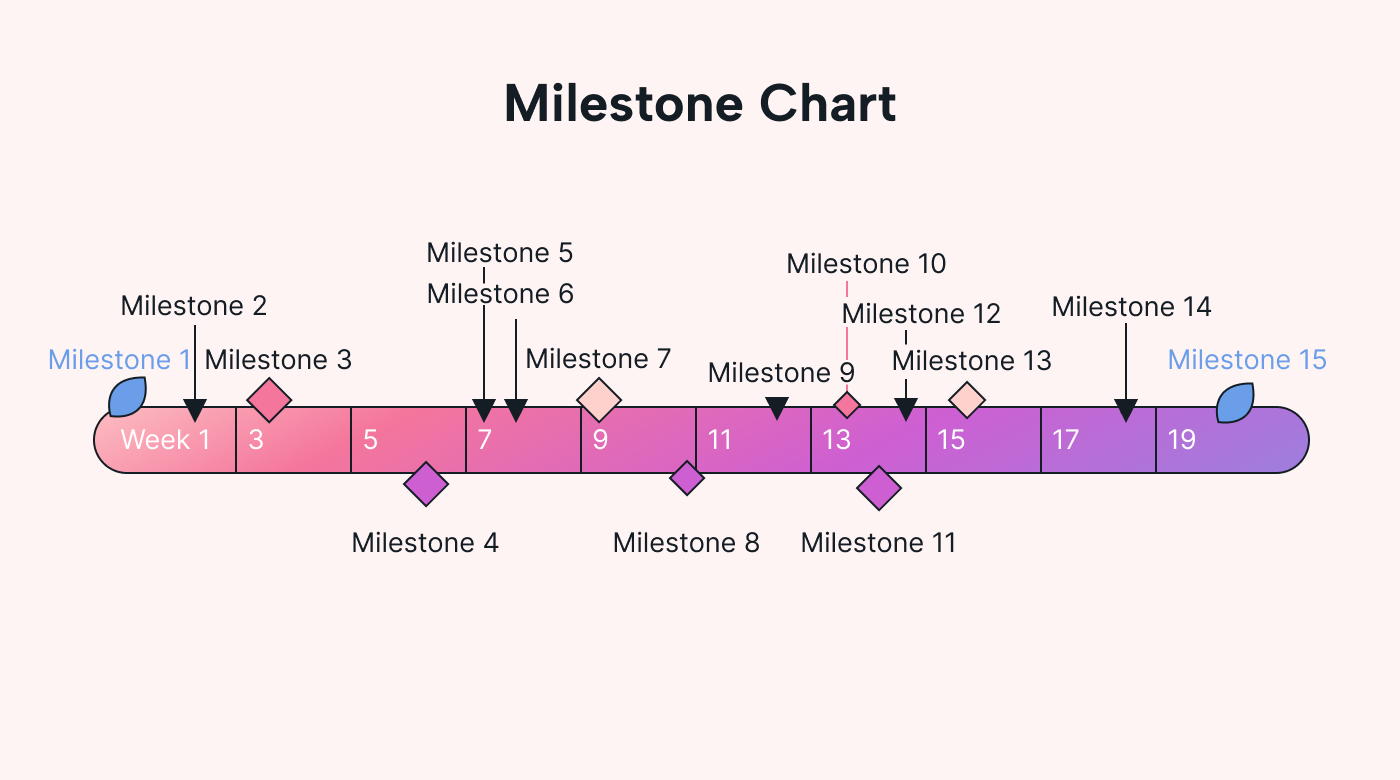 |
When represented correctly on a Gantt chart or project (or program) evaluation and review technique (PERT) chart, it's always a task of zero duration dependent on completing a group of tasks preceding it. Completed milestones also motivate the team, allowing them to celebrate successes along the way and stay on track.
What is a milestone chart?
Before we dive into the details of creating a milestone chart, it's essential to understand why it matters. Keeping track of your progress is crucial in any project, whether large or small, personal or professional.
A milestone chart is an effective tool for keeping everyone on the same page and ensuring the project moves forward as planned. With a milestone chart, you can identify potential roadblocks, keep track of completed tasks, and make adjustments as necessary to stay on track.
Benefits of milestone charts
Milestone charts offer several key benefits in project management:
- Clear visualization of project milestones and deadlines: Milestone charts provide a clear visual representation of the project timeline, making it easier to understand when specific project deliverables are due.
- Improved communication among team members: By keeping everyone informed about project progress, milestone charts help foster better communication among team members. This leads to a more collaborative and productive work environment.
- Better tracking of project progress and potential roadblocks: Milestone charts allow project managers to show progress at a high level, and identify potential roadblocks early on.
- Increased accountability and transparency: Milestone charts provide a clear record of project progress, helping stakeholders see progress, and helping the project manager to communicate it. This transparency also helps build trust between team members and stakeholders.
In conclusion, milestone charts are an essential tool for project management and business stakeholders. They provide a clear visual representation of project progress, foster better communication among team members, and help identify potential roadblocks early on. They are great tools for demonstrating progress to stakeholders and senior management, too.
Key prerequisites for a milestone chart
Now that we know why milestone charts are so valuable, let's explore what’s needed to make one.
Project schedule
When you are managing a project, it is important to create and maintain a project schedule from which to derive a high-level milestone plan later on. A project schedule outlines the tasks, resources and time needed to complete the project. It helps to track your project's progress and should be updated by comparing performance against KPIs for the schedule.
Creating a project schedule can be challenging as there are many factors that need to be taken into consideration such as task duration, resource availability, and budget constraints and dependencies between tasks. However, this is a key part of your project plan and therefore essential.
Timeframes and deadlines
The project schedule, when done right, will produce the planned start dates and durations for each task. When developing your schedule, it's important to consider any dependencies between tasks. For example, if one task can't be completed until another is finished, you'll need to account for that in your timeline.
It's also important to be realistic when building your schedule. Make sure to account for the required effort, available resources and dependencies in your project schedule to determine when tasks can be completed.
Also think about any potential delays or unexpected issues that may arise during the project and document them in your risk management and contingency plans. Your milestone chart will be easy to develop as a result of your schedule planning efforts.
Responsibilities
Every task in your project plan must have a person responsible for completing it. This individual or team should be assigned to the task with clear instructions.
When assigning responsibilities, it's important to consider each team member's strengths and expertise. Assign tasks to individuals with the skills and knowledge to complete them successfully.
It's also important to communicate clearly with each team member about their responsibilities and critical project deadlines. Make sure everyone is on the same page to avoid confusion or misunderstandings.
Milestones
Once the project schedule, and responsibilities are clear, milestones can be derived from your schedule. These are the key goals or checkpoints that need to be completed to reach your project's final objective.
Milestones can be added to your schedule as tasks with zero duration. The milestones should depend on completion of the tasks that when done, represent achievement of a major objective for the project. Some examples of milestones are: completing a key deliverable, entering a new project phase, completing a major design review, or finishing an important user acceptance test.
For example, if you are building a new website, the milestones occur once you complete a major group of tasks. Your milestones could be, for example:
- Homepage design finalized and approved
- Navigation menu completed
- Website copy created and approved
It's important to take the time to carefully identify each milestone to ensure that you aren't missing any key steps in your project plan.
By creating these key components sequentially, you can create a schedule that will help keep your project on track, and produce a realistic milestone chart in the end.
Choosing the right milestone chart format
Given that you understand the prerequisites of a milestone chart, let's look at the different formats you can choose from to create your own chart:
Gantt charts
Gantt charts are one of the most popular formats for milestone charts, and for good reason. These charts are often used for complex projects with milestones across different phases. Gantt charts offer a visual representation and clear horizontal timeline view of the project's progress, making it easy to see what's been completed and what still needs to be done.
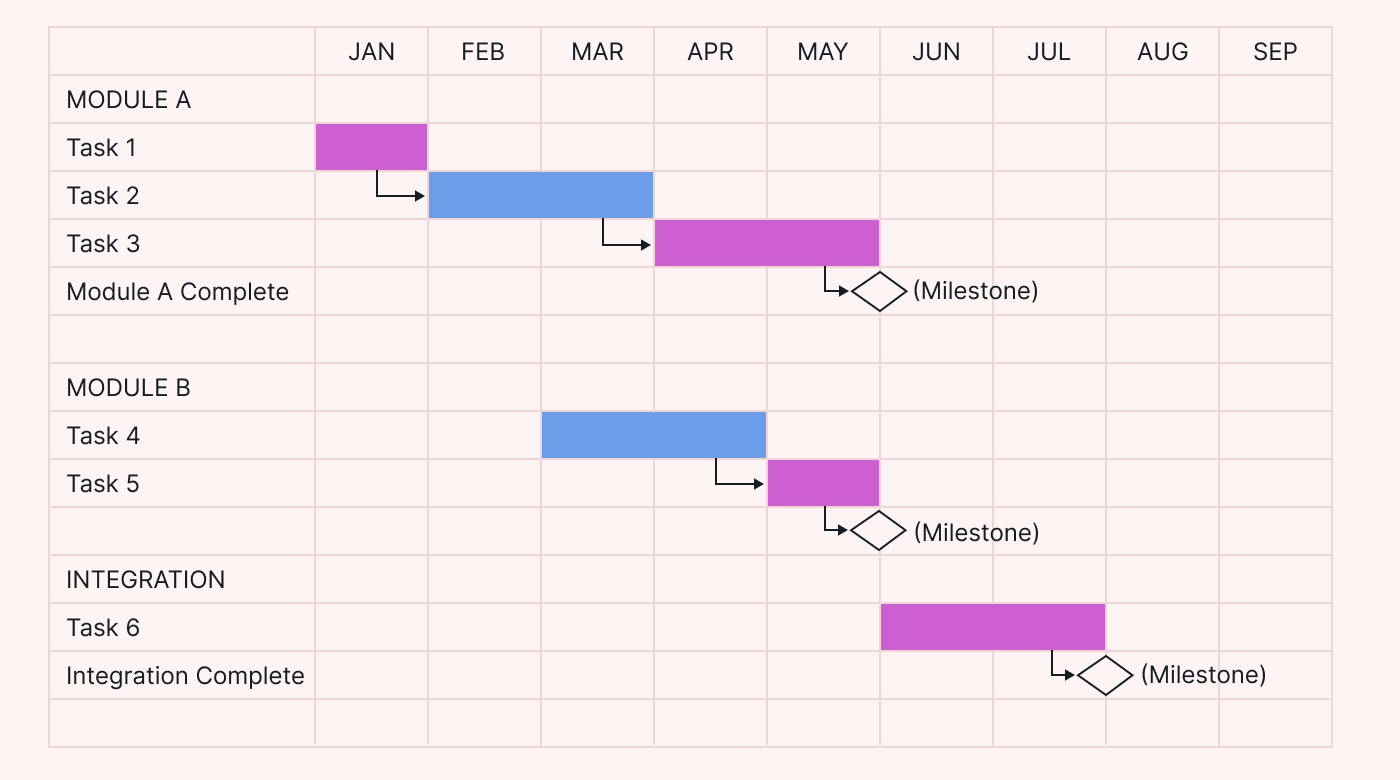 |
One benefit of using a Gantt chart is that it allows you to show all the milestones in your project schedule. By seeing the milestone tasks in the project schedule, you can use it to extract the target dates for each milestone. Later, as progress is made, you can use it to extract actual achievement dates as well.
Kanban boards
Kanban boards are often used in Agile project management methods. These boards are flexible and offer a more fluid approach to milestone tracking in projects where the scope and timeline are subject to change over time.
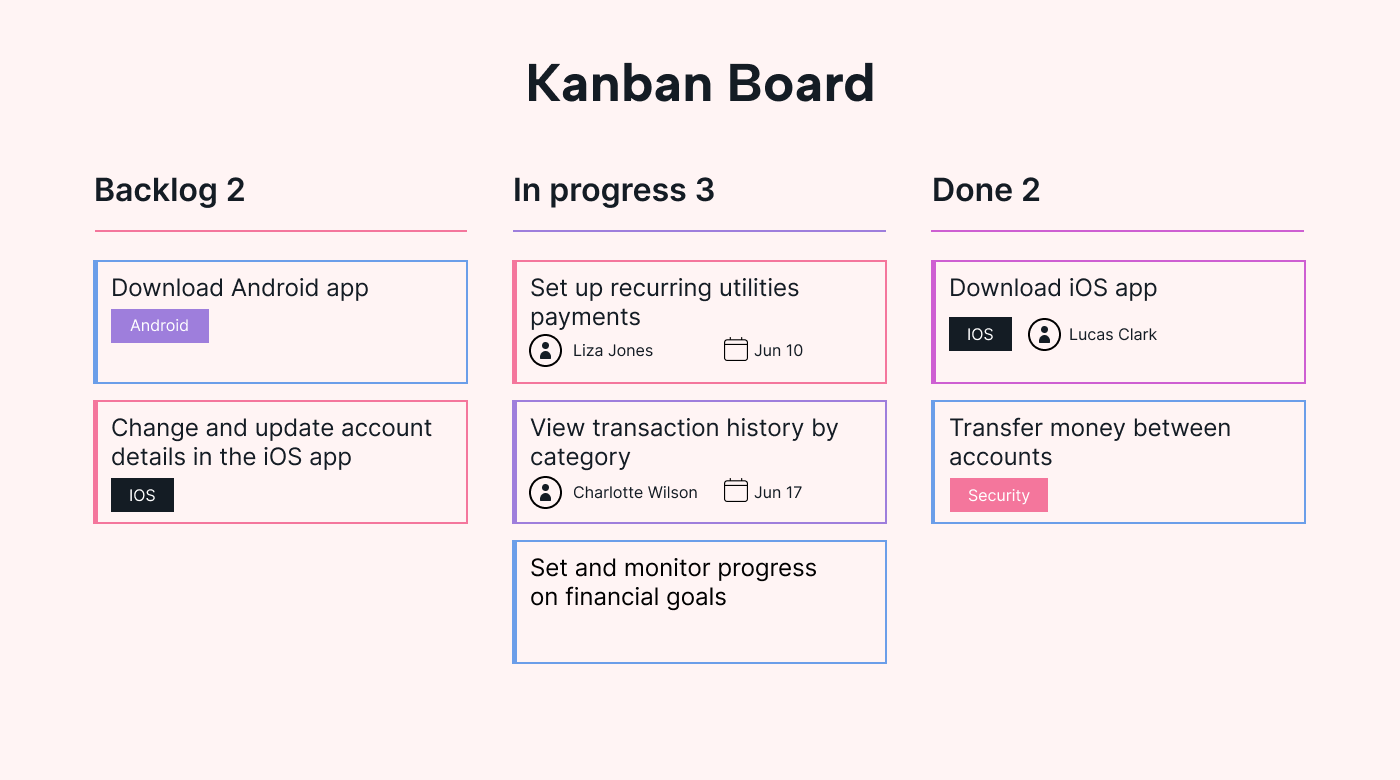 |
Milestones in agile projects might be completions of sprints, or completions of major portions of the product backlog. One of the benefits of using a Kanban board is that it allows you to visualize the entire project workflow in one place.
Project milestone chart
A milestone chart is a project management tool used to visualize the milestones of a project. It typically shows each milestone and its associated due date, allowing project managers to track progress and plan for upcoming tasks.
Milestone charts differ from Gantt charts and Kanban boards in that they show just the milestones rather than all the tasks. Gantt charts show the timeline of a project, while Kanban boards manage tasks within a project.
Milestone charts provide an overview of the entire project timeline, helping project managers communicate with stakeholders about the progress of the project. They are exciting for project team members to celebrate their successes, too.
When choosing the right milestone chart format, there's no one-size-fits-all solution. Each format has its own benefits and drawbacks, and the best option will depend on the specific needs of your project. By understanding the different formats available and their benefits, you can choose the one that'll work best for you and your team.
Creating your milestone chart
Project management can be daunting, but with the right tools, you can ensure that your project is completed on time and to everyone's satisfaction. One such tool is a milestone chart, which helps you show the progress of your project. In this section we’ll identify the steps required to create your milestone chart.
Remember the prerequisites we talked about earlier. If those are available, making your milestone chart is a breeze. If it is very early in project definition, you may want to perform a high level version of those prerequisites and produce a fortune-teller’s version of the milestones.
Step 1: Define your project goals
Before creating your milestone chart, know your project's goals. The goals should be specific, measurable, achievable, relevant, and time-bound. It's important to ensure that all team members and stakeholders are in agreement with these goals, as they'll serve as the foundation for your entire project.
For example, if your project is to launch a new product, your goals might include:
- Develop a product that meets the needs of our target customers
- Create a marketing plan that effectively promotes the product
- Launch the product by a specific date
Step 2: Break down goals into smaller tasks
Once you've defined your project goals, you need to break them down into the major items that need to be delivered, or the major phases. Those can be the basis for your milestones. For example, if your goal is to develop a product that meets the needs of your target customers, your milestones might include completion of each of the following:
- Conduct market research to identify customer needs
- Develop product specifications based on research findings
- Create a prototype of the product
- Conduct user testing to refine the product
Step 3: Establish milestones and deadlines
With your list of milestones in hand, it's now time to establish estimated deadlines or timeframes for each one. If your team is formed, this can be done in collaboration with all team members to ensure everyone has an understanding of expectations.
The deadlines of course are based on how long you expect each of the major activities to take, and what they depend on. Set realistic deadlines that take into account any anticipated problems.
Step 4: Assign tasks and responsibilities
If you have your schedule, each task is assigned to a person or team with clearly defined responsibilities. If you don’t have your schedule yet, you can estimate how long each of these major activities will take.
For example, suppose your milestone is to complete a prototype of the product. Use the estimated times of all the necessary tasks to complete the prototype from your schedule. If you don’t yet have a schedule, or estimate the length of time you expect it to take based on your experience.
Step 5: Choose a visual format and create your chart
With all the necessary information in hand, choose a milestone chart format that suits your project's needs. As discussed, there are many different formats to choose from. Then, create your chart to share with all team members and stakeholders for ongoing progress updates and adjustments as needed.
For example, you might have used a Gantt chart to develop your schedule. Most Gantt chart software will allow you to show milestones. Or you can create a high level Gantt chart to estimate your project timeline and milestones.
Milestone chart example
Milestone charts can be used for any project. They are often used for software releases in order to show the different stages of development and testing. For example, a software release may have milestones for design, coding, testing, debugging, and deployment.
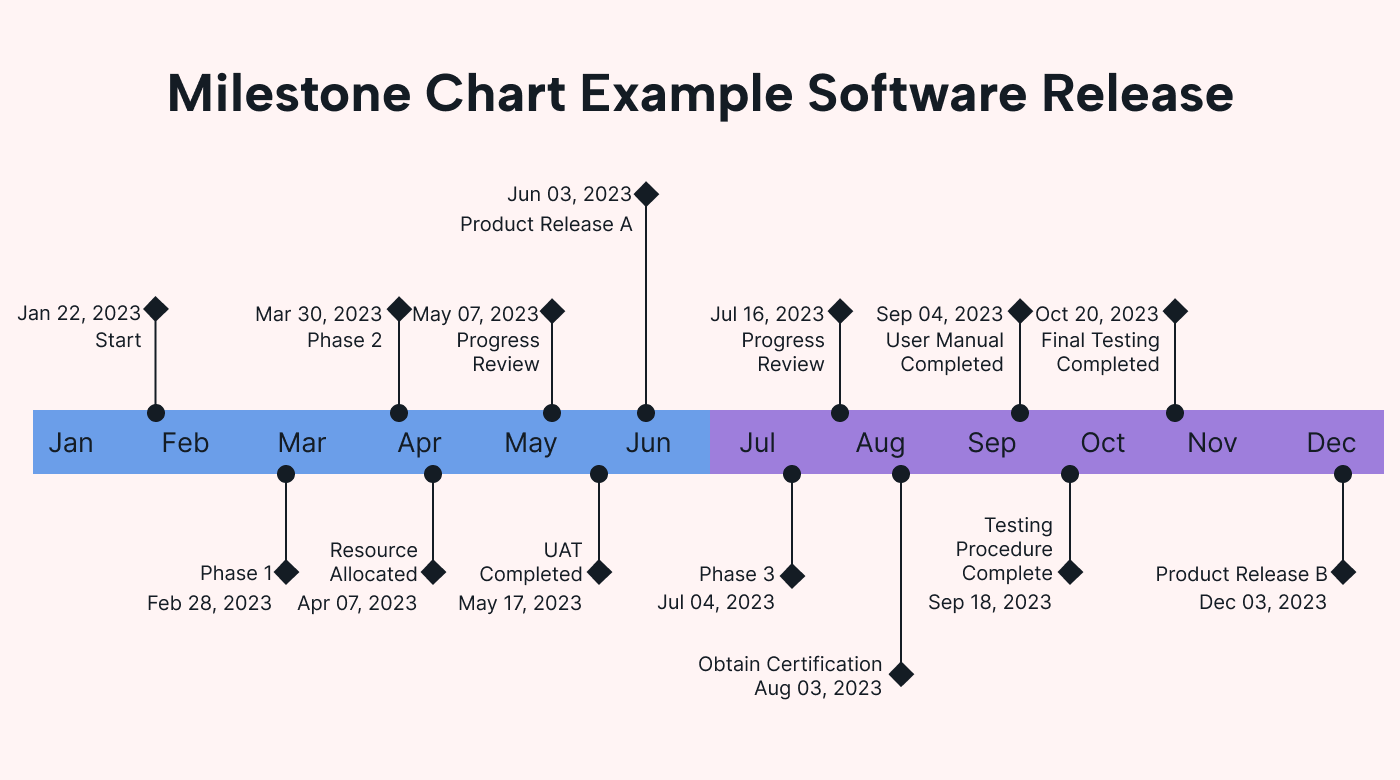 |
By breaking down the project into high-level chunks and demonstrating progress with a milestone chart, it's easier to communicate progress with both project stakeholders and senior managers.
Let Motion do the scheduling for you
To conclude, a milestone chart is an incredibly effective tool when managing your projects. You'll be able to show the completion of major achievements and your project's progress from milestone to milestone. So it is a handy 'PR tool' to update stakeholders and build the morale of your team.
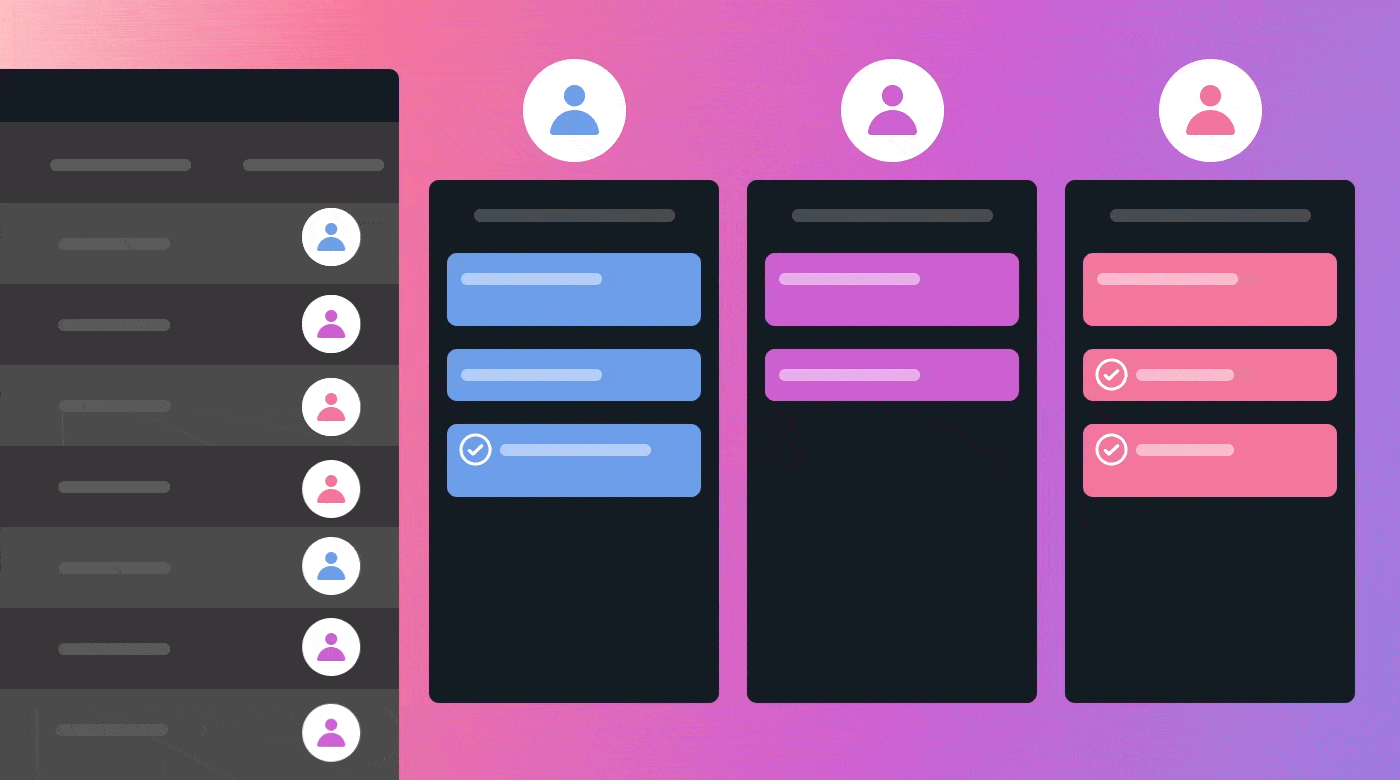 |
Plus, they're super easy to make and customize to your project's specific needs. When it comes to staying ahead of your projects, a well-defined milestone chart should give you the clarity you need to keep things running smoothly.
So if you're looking for a way to easily track progress and prioritize tasks, start creating your tasks and milestones today! Or better yet, let Motion do the scheduling for you — try Motion today. With Motion's AI-supported priority-based scheduling, you can smoothly manage progress at every step of your project and ensure its success with less manual effort on your part.





